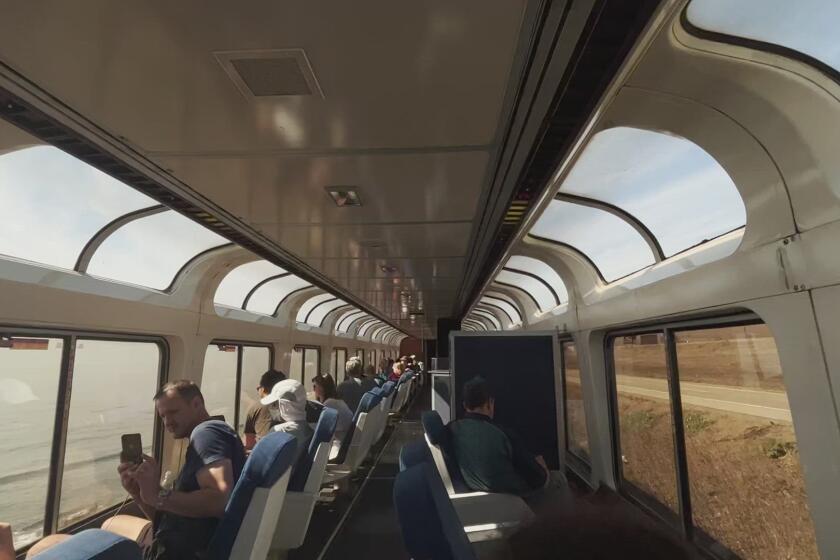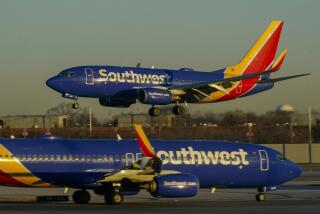I spent $399 on Frontier’s ‘All You Can Fly’ pass. Is it worth the hype?
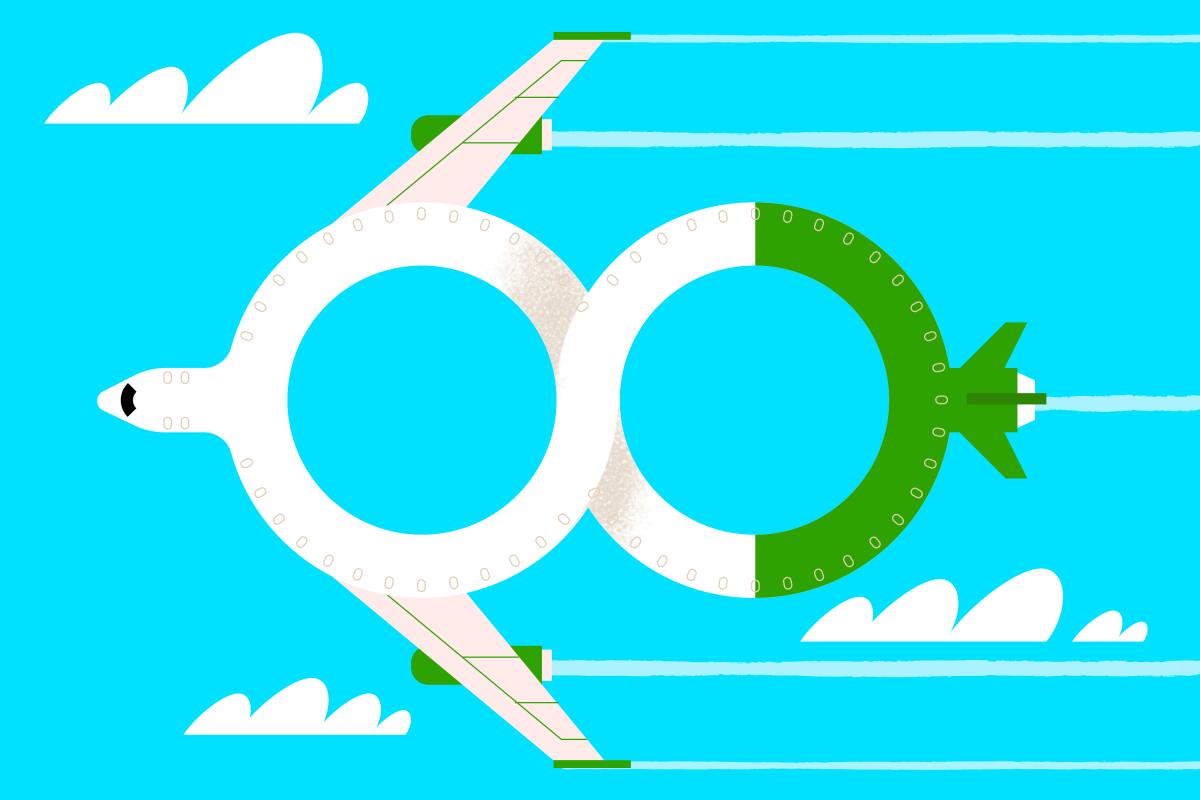
- Share via
As a person who takes many last-minute trips, I’m used to flying on budget airlines. I’ve traveled thousands of miles on JetBlue (my ride-or-die), TAP Air Portugal (amazing), Vueling (decent), Ryanair (can you tell I studied abroad in Europe?), French Bee (they lost my bag at Paris Orly for nearly a week) and Spirit (who among us wouldn’t buy a $45 round-trip ticket to see Pitbull play in Nashville?). Yet Frontier Airlines didn’t come across my radar until more recently.
The Denver-based low-cost carrier caught my attention last November when the company announced it would be launching the GoWild! All-You-Can-Fly Pass. Its premise was simple: Users can book unlimited flights for fares of 1 cent (plus taxes and fees). Summer passes, for May 2 to Sept. 30, started at $399 and are $499 until May 31. (After that date, the price will revert back to $999, though Tyri Squyres, Frontier’s vice president of marketing, said the passes may sell out entirely this month.) Annual passes, which are good for a calendar year starting May 2, started at $599 and are currently on sale for $1,999.
For Frontier, which carries around 25 million passengers annually, the pass is a remedy for a problem that many airlines face. “The real genesis of the pass is we’re flying thousands and thousands of empty seats every day,” Squyres said. “Why not give them to folks?”
Perhaps you’ve come across this popular train on TikTok, where people rave about its gorgeous observation cars. Here’s what the ride in coach is really like.
Unlimited flight passes have, of course, been around for years. And while such programs are always enticing, they tend to go wayward. In the 1980s, American Airlines let a few dozen lucky people purchase unlimited lifetime AAirpasses for upward of $250,000, but the airline eventually rolled some of the passes back. In 2009, JetBlue launched a more modest monthlong “All You Can Jet” pass for $599 that sold a little too well, which led them to suspend sales. The most comparable program currently on the market seems to be Alaska Airlines’ limited Flight Pass, which launched in February 2022 and allows people to pay a flat rate for six, 12 or 24 trips per year within California, Nevada, Arizona and Utah.
When the GoWild Pass was announced, intrigue soared, with writers describing the program as “built brilliantly” and “chaotic, but might be worth it.” Soon enough, people jumped online to figure out if the deal was too good to be true. “What are the downsides to the $599 Frontier Airlines ‘Go Wild!’ pass?” one Reddit user posted. “Is round-trip possible with the GoWild! pass?” another asked. (Because you’re only allowed to book domestic flights 24 hours in advance and international flights 10 days in advance, the answer is essentially no.) There were questions about seat availability, cancellation fees and luggage.
But parsing through the fine print didn’t seem like it would get me all the answers I wanted, so I did what any travel reporter would do: I begged my editor to let me try it out.
Here’s what happened when I put my pass to the test.
Confusion over airports and routes
Because Frontier doesn’t operate out of Los Angeles International (which is two miles from the L.A. Times’ office), I learned that my closest airports would be John Wayne Airport in Santa Ana (45 miles away) and Ontario International Airport (55 miles away).
Though Frontier previously offered flights from Hollywood Burbank Airport, it recently stopped. Squyres said that Frontier makes changes to its flight network seasonally “to meet where there is the greatest customer demand.” (Frontier’s top flight hubs include Denver, which has 63 routes; Las Vegas, which has 60; Orlando, which has 49; and Atlanta, which has 38.)
Looking at Frontier’s route map, I found that Frontier flies to three destinations from John Wayne Airport: Las Vegas, Denver and Dallas. If I wanted to take an international trip, I’d likely have to drive to the Ontario airport (which offers Frontier flights to eight U.S. destinations), take a flight to one of the international airline’s major hubs and then fly to my final destination.
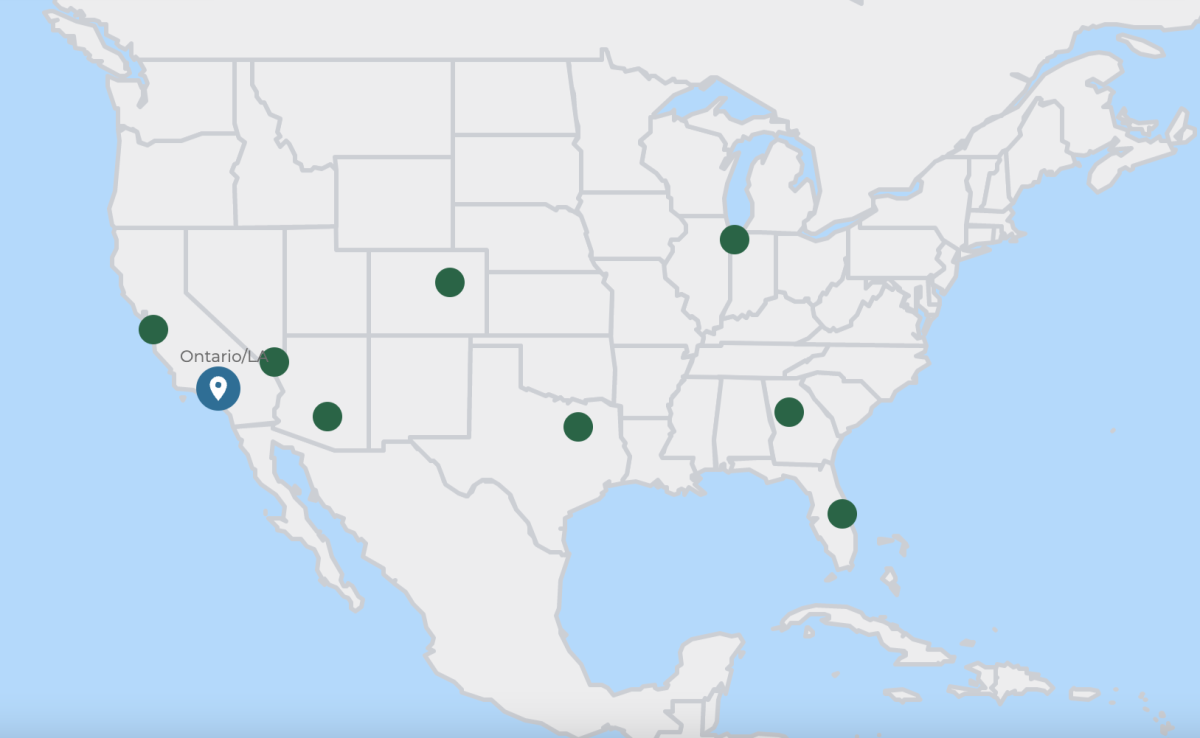
Confusion about which routes and airports Frontier is flying has frustrated some GoWild users. “A lot of people are buying the pass and then they’re finding themselves unable to get to destinations they want to go because their airport doesn’t have many options,” said Sarah Yi, 46, a frequent flier based in New York City. The first time she used her GoWild pass, due to a long layover, it took 14 hours to get to Dallas, a destination that’s typically a 2½-hour flight.
Sticker shock over the real ticket prices
After looking through my flight options, I decided to book a round trip from Ontario to Denver to visit a friend. (Frontier allows advance booking for GoWild pass holders during certain promotional periods.) All domestic flights seemed to be around $15 minimum for each leg of the trip, lining up with this line from Frontier’s FAQ: “Current government and airport taxes, fees and charges start at approximately $14.90 per person, per flight for domestic travel.” Accounting for just the 1-cent fare and the taxes and carrier imposed fees, the round trip cost $29.82.
Though $30 isn’t bad for a short-haul round trip, it’s not exactly what travelers might be picturing after spending hundreds of dollars on an unlimited pass that was advertising 1-cent fares.
Pro tips from Times travel journalist Christopher Reynolds on visiting national parks, saving on LAX parking, checking a hotel’s fine print and more.
For the record:
3:49 p.m. May 12, 2023A flight from Miami to San Juan is a domestic flight. A reference to it being an international flight has been removed.
International flight pricing was particularly surprising because of the steeper taxes and fees. No matter which day or week I looked at, Denver to Cabo San Lucas came out to a minimum of $175.35 and Denver to Cancun seemed to bottom out at $148.55.
Monique Henderson, 45, bought a summer pass to take advantage of her summers off as an educator. “I wasn’t sure if this is going to be a bait-and-switch thing where they fake you into buying this pass and then there’s so many limiting factors [that] you can’t really use it,” she said.
However, so far, Henderson said the pass has been working flawlessly, and she’s flown to San Salvador, Guatemala City, Cancun, Miami, Atlanta and Los Angeles. “I think people who did not read the bylaws in their entirety are definitely going to be sticker-shocked at some of the costs to fly international,” she said. Still, she believes that when she weighs how much she’s saving on these trips, “it’s still worth it.”
A note about add-ons: Though personal bags like a small backpack or purse (smaller than 18 by 14 by 8 inches) are free to bring on board, adding a carry-on bag (24 by 16 by 10) or a checked bag (62 total inches and less than 40 pounds) would cost me $55 per each one-way flight at the time of booking. (Jennifer DeLaCruz, Frontier’s senior director of corporate communications, said she could not provide a price range for bags, since pricing is dynamic and can change from flight to flight.)
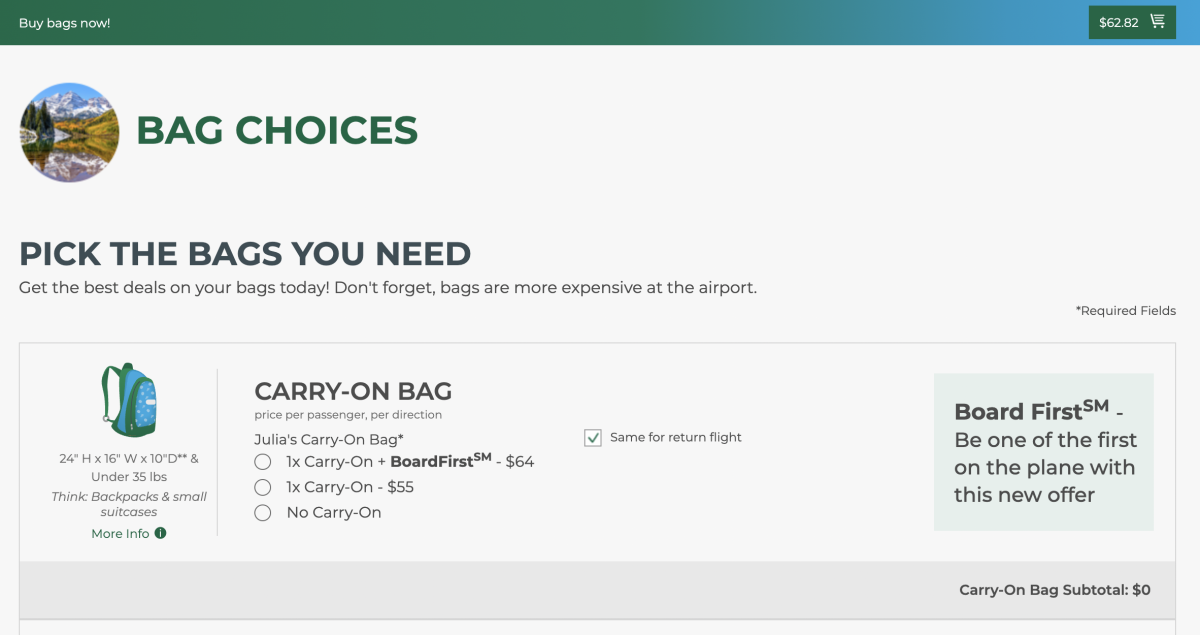
Seat options on my flight cost $16 to $34, though there is an option to skip seat selection entirely. After the option to add bags and select seats, there’s also an option to add “airport agent assistance” for $20 per person, per direction.
I decided to pack my things into a personal item-sized soft backpack in both directions and only selected a seat on my return flight, which cost an extra $33. I did not opt for airport assistance. My grand total was $62.82.
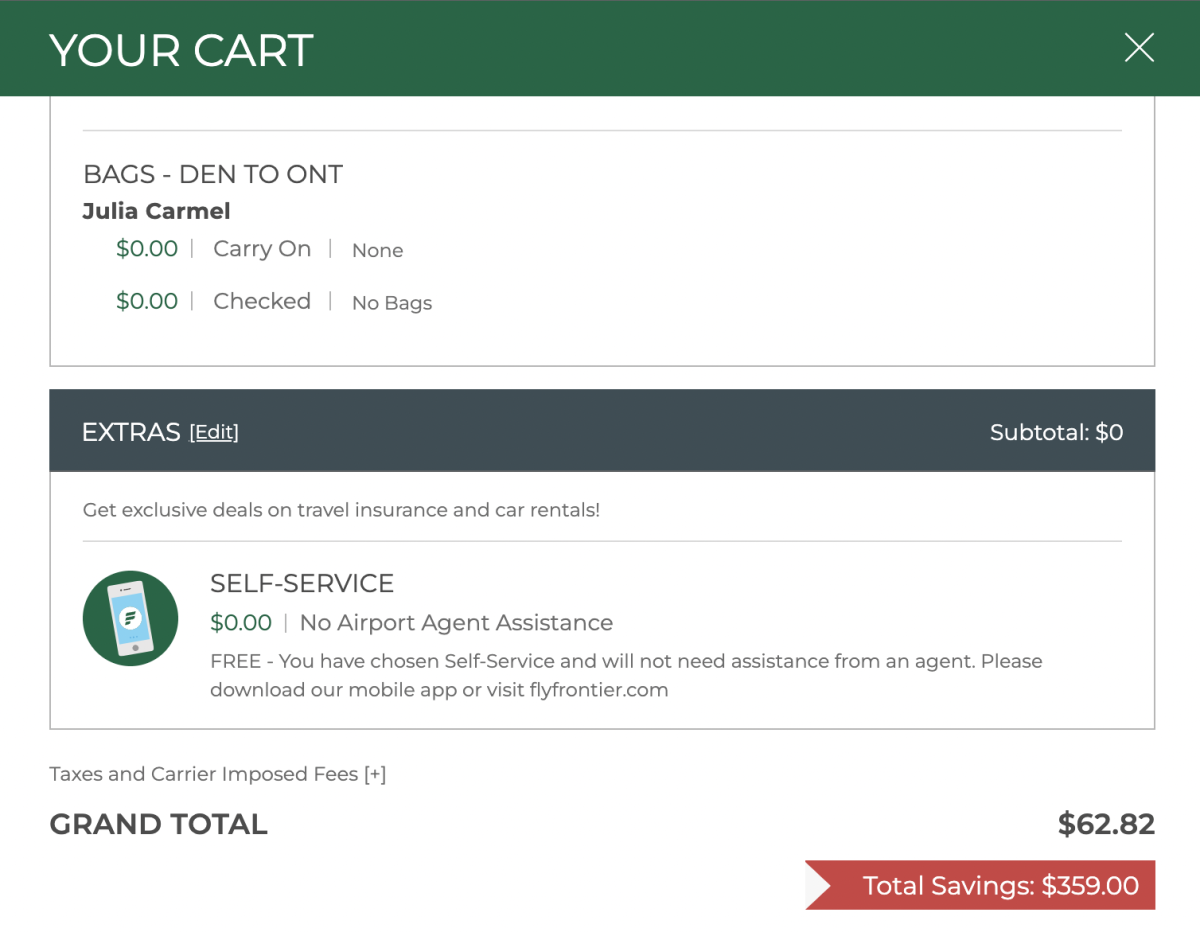
Then came the actual flight
I arrived at the Ontario airport around 4:45 a.m. for a flight that started boarding at 5 a.m. After making it through the TSA Precheck security line in a smooth 15 minutes, I ran to my gate to make sure my group wasn’t boarding yet.
At the gate, a steady stream of people was filing onto the bridge. As I’d seen on social media, Frontier employees were making every person verify that their personal bags fit within a metal box the size of the airline’s personal item limit. Though I didn’t have trouble, I watched several people reconfigure their bags by taking out pieces of clothing and putting on additional layers.

The plane was basically what I expected, filled with thin, screenless seats that do not recline. The seats were also quite narrow, but I (thankfully) ended up in a window seat, which gave me a few more inches of room when I flipped up the armrest.
On my way back from Denver, at the gate next to mine — a Frontier flight heading to Seattle — an argument broke out between the desk agent and a passenger when the agent didn’t allow the passenger to board with his backpack.
“What kind of system is this? My bag fits,” the passenger said repeatedly as he pleaded his case to different Frontier employees. All the while, he was pointing to a bag that clearly fit within the personal item holder.
“Why would I pay $100 for a bag that fits?” he kept asking.
But before I could see whether they’d let him and his bag on the flight, my gate began boarding.
For this flight, I opted for one of the roomier seats, which cost an extra $33. As someone with long legs, upgrading from the last row of the plane to the first was worth every penny.
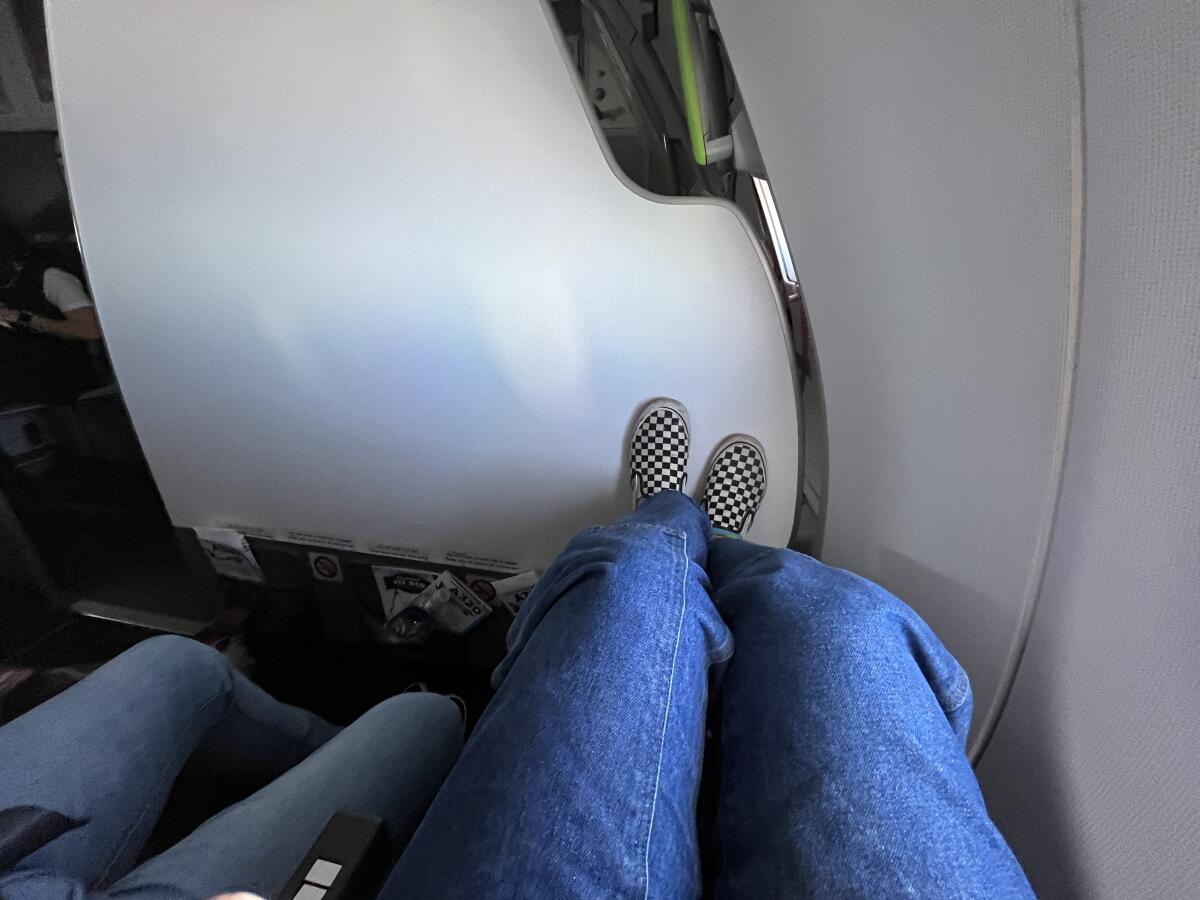
We landed in Ontario 30 minutes early, and though it was a welcome surprise, I wondered how often Frontier’s flights run ahead (or behind) schedule.
“I do have to say every flight I have taken has taken off early, and I’ve never seen that before, to the point where they actually leave passengers behind,” Yi said. She added that she’s seen Frontier close boarding gates 45 minutes early and she once met a group of passengers who were left in Dallas when their flight to Cancun closed its gate 75 minutes early.
“The lesson I always tell people is get traveler’s insurance and use a credit card that gives you travel protection when it’s not airline related,” Yi said.
When I asked about flights leaving early, Squyres said, “That doesn’t make sense for us to even do that, so I’m skeptical on that one. But there may have been a communication issue.”
Travelers’ woes
Like most airlines, Frontier isn’t particularly popular online: It’s been the subject of a viral “1… 2… 3… Frontier lost all our luggage” TikTok video, criticized for charging people $99 for personal items that fit within the required measurements and called out for giving incentives to agents who charge passengers baggage fees at the gate.
“We had to come up with something that would actually make sure that we were enforcing our policies fairly,” Squyres said of the bag incentives.
Even the airline’s own self-deprecating content is flooded with comments about lost luggage and expensive bag fees. (For what it’s worth, Frontier’s percentage of mishandled luggage is lower than many major U.S. airlines.)
Last November, Frontier was also fined $2.2 million for not refunding $222 million to passengers who had flights canceled during the pandemic. Soon after, Frontier eliminated its customer service phone number.
“We still do have a contact center with live people who are communicating with our customers,” Squyres said, referring to the company’s chatbot. “Most customers, we find, would prefer not to actually have to talk to somebody.”
Hiking trails, camping spots, museums, food festivals and restaurants. Here are the California spots a Times’ travel writer can’t wait to visit.
There are also stories of canceled flights. Tanya Handy, 43, often travels between Ohio and Iowa for work, which made the annual GoWild pass especially appealing. But when she booked her first flight with the pass in April, to travel from Cedar Rapids to Cincinnati via a connection in Denver, she arrived at her gate and received an email saying her second leg, from Denver to Cincinnati, had been canceled without explanation. “I had to book my own hotel room,” she said. “There were no other options of booking another flight back home — or anywhere, for that matter.” She ended up booking a flight on Southwest the next morning.
When asked about whether Frontier offers reimbursement or assistance for pass holders who encounter canceled or delayed flights, Squyres couldn’t offer a simple answer.
“Operationally, obviously, we’re always trying to get customers from Point A to Point B, that’s why you buy a ticket with us. That’s your expectation,” she said. “And things do complicate that. Weather is is a big one and an ugly one. And sometimes, you know, things happen. And flights get disrupted.” When issues arise, Squyres said Frontier works with all of its customers, including GoWild pass holders, in the same way.
But for many, the pass is working out just fine
With all the ups and downs of the pass taken into account, many fliers are quite satisfied with their purchases.
Jacob Brown, who has flown Frontier more than 100 times in the last few years, has encountered many disgruntled users as a moderator for a Facebook group with nearly 4,000 GoWild Pass holders. But Brown believes that most of the frustrations come from user error.
“Nobody’s trying to hide anything from you,” said Brown, 22, who created his own GoWild guide (entirely unaffiliated with Frontier) to answer common questions about the pass. “I think that [Frontier is] being super clear with the advance booking window, and the FAQs on the website have been updated as things have come up.
“A lot of people jump to conclusions,” he added. “The first time they want to go somewhere and they look and a flight isn’t available, they think it was a waste of money. The whole point of the pass was not to get guaranteed seats. It was for really quick getaways and last-minute flights.”
So far, Brown has found his own annual pass to be worth the cost. “They’re already being gracious with things like extending the booking window, so we’re already getting a lot more than what we bargained for, in a positive way,” he said.
Jasmine Martin, 27, is also a fan. She has already booked two trips so far with their summer GoWild pass, and has been able to link their pass with their daughter’s pass, which ensures that the two of them will be seated next to each other at no cost. “I know it’s weird, but I love Frontier,” Martin said. “The only time that I’ve had an issue was the time our flight was delayed seven hours.”
Regardless of Frontier’s reputation, Martin is excited to take advantage of the pass while her daughter is on summer vacation.
“The seats aren’t that comfortable,” they added, “but I mean, you’re getting there for $14, so who cares?”
Would I buy the pass again?
There have been times in my life when this pass would’ve been perfect. When I was in a long-distance relationship, traveling for months at a time between New York and Los Angeles, I would have jumped at the chance to book $15 tickets the day before flying. (Booking routine trips to visit someone who is close to you and is flexible with when you’ll leave seems like a surefire way to make the pass worthwhile.) And I certainly appreciate the giddiness of frequent fliers who use the pass to plot cross-country day trips to try special sandwiches and check off other bucket-list items.
But right now, all things considered, I don’t think I’ll get my money’s worth out of this pass. If there were flights out of LAX, or even just more direct routes available from local airports, my thoughts might be different, but I can’t see myself driving to Ontario or Santa Ana often for impulsive trips with long connecting stops.
Still, I’m hoping to use the pass a few more times this summer. Perhaps I’ll get the momentum to hop on a flight to Philadelphia or Miami to visit old friends during my next slow weekend. It won’t be the most convenient journey, but as we as travelers keep learning, every cheap flight comes with a price.
- Share via
Watch L.A. Times Today at 7 p.m. on Spectrum News 1 on Channel 1 or live stream on the Spectrum News App. Palos Verdes Peninsula and Orange County viewers can watch on Cox Systems on channel 99.
More to Read
Sign up for The Wild
We’ll help you find the best places to hike, bike and run, as well as the perfect silent spots for meditation and yoga.
You may occasionally receive promotional content from the Los Angeles Times.
